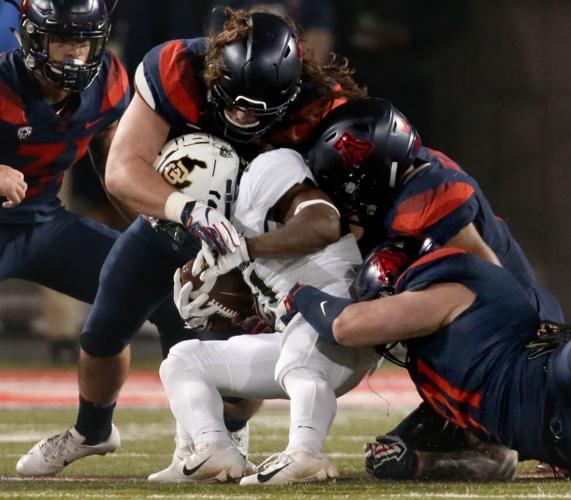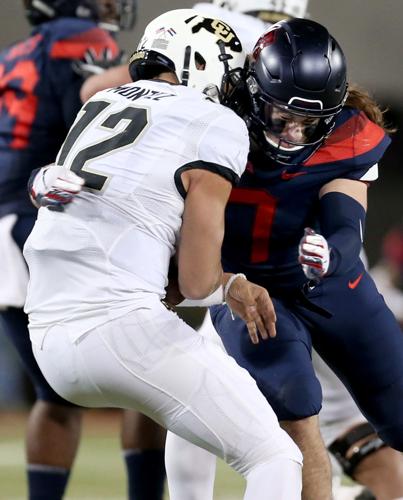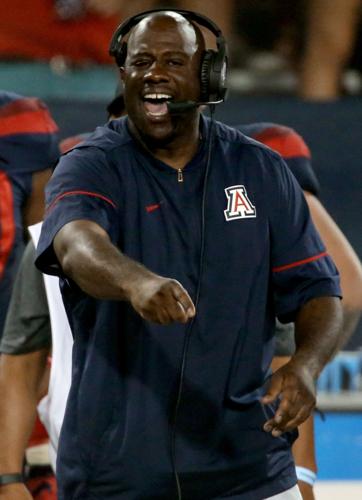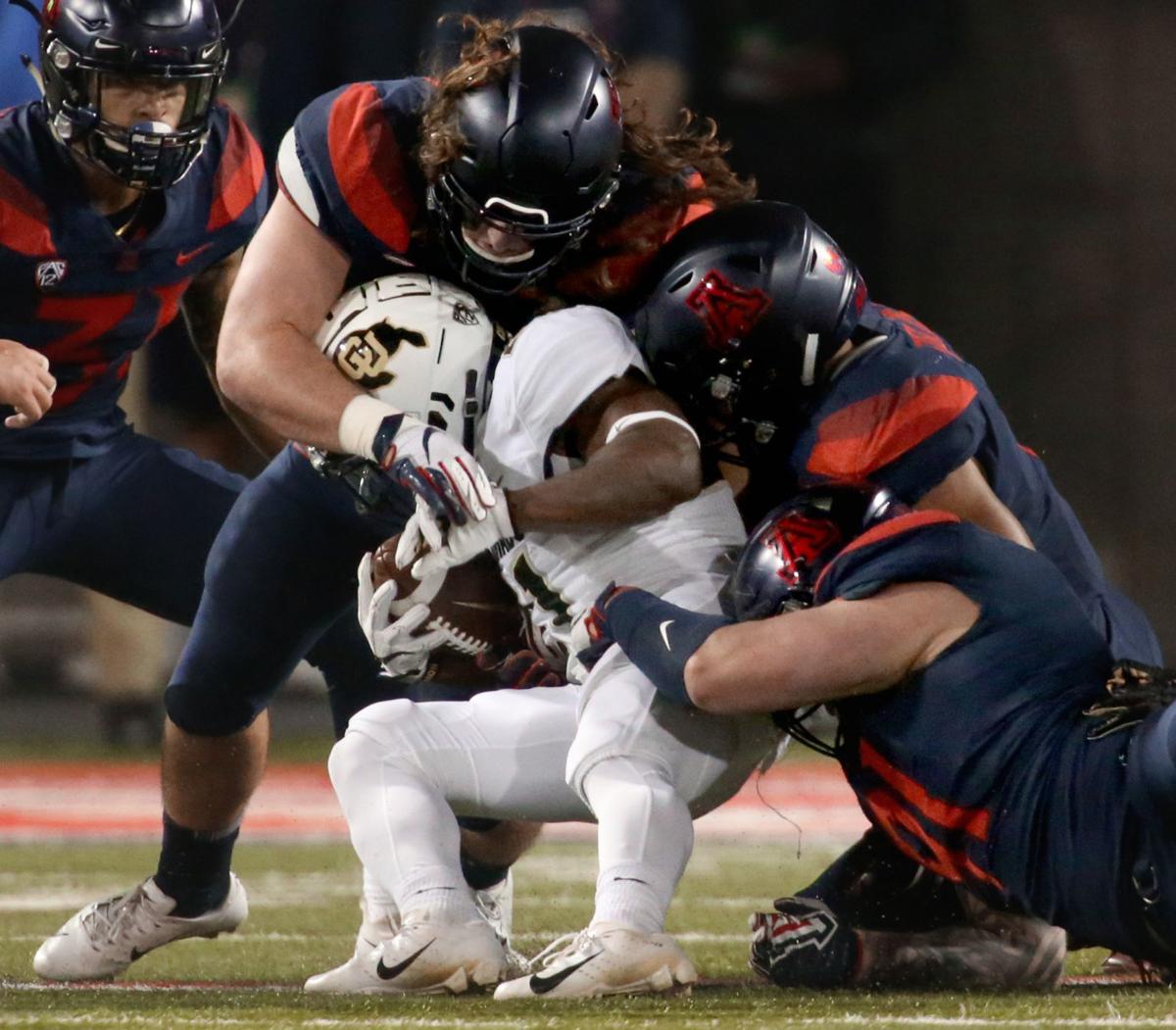The Arizona Wildcats’ defense improved in a variety of ways last season. It allowed fewer points per game. It took the ball away more often. It generated more three-and-outs.
But the unit wasn’t quite where anyone wanted it to be. Arizona still ranked in the bottom four in the Pac-12 in the most significant categories: points allowed, total defense, rushing defense and passing defense.
So it was only logical to ask third-year defensive coordinator Marcel Yates what step the defense needed to take next.
Yates didn’t hesitate.
“Our next step is to be a lot better against the run,” Yates said during training camp.

Editor’s note
Each week throughout the football season, we’ll take an in-depth look at the Arizona Wildcats from a statistical perspective.
He referenced quality defenses he had coached in the past. In Yates’ last season at Boise State before coming to Arizona, the Broncos ranked fifth in the nation in run defense.
“When we were good, we were stopping the run,” Yates said. “We’ve gotta get better at fitting our gaps. We’ve gotta get better being downhill.”
It took a while — longer than Yates or anyone associated with the defense had hoped — but the Wildcats finally are getting better against the run. The numbers reveal just how much.
In the past two games, against Oregon and Colorado, Arizona surrendered a total of 124 rushing yards. The previous eight opponents averaged 195.9.
The Ducks and Buffaloes averaged 2.25 yards per carry. Arizona’s previous eight opponents averaged 4.41.
Limiting consecutive foes to fewer than 100 rushing yards isn’t something that happens often around here. The last time Arizona did it: 2011. The last time it happened in Pac-12 play: 2010. (We’ll have more on the ’10 Wildcats in a little bit.)

Linebacker Colin Schooler, right, and the Wildcats are allowing only 4.12 yards per carry this year, almost a half-yard better than last season.
Colorado’s 40 net rushing yards were the fewest by a UA opponent since Washington State had 51 last season. But the defense’s performance last Friday was much more meaningful.
Mike Leach’s Cougars, whom the Wildcats visit Nov. 17 after this week’s bye, operate the most pass-heavy offense in the country. They averaged just 68 rushing yards per game last season, the second fewest in the nation. Take out the UA game, and that figure barely changes: 69.4.
Arizona held Colorado to 137.4 yards below its average against other opponents (177.4). Oregon’s 84 yards were 105.4 below its average in other games (189.4).
The Buffs’ rushing stats are a bit misleading because they surrendered five sacks totaling 38 yards. Unlike the NFL, sack yards are deducted from team rushing totals in college football.
But even if you take out the sack numbers, Colorado still ended up with only 78 yards on 27 attempts — an average of 2.89 yards per rush.
The average-per-carry stat is an important one to focus on. Starting with the UCLA game — the Bruins rushed for 153 yards but needed 47 carries to get there — Arizona has limited its past three opponents to 2.72 yards per rush. Its previous three foes — USC, Cal and Utah — averaged 5.07.
When you look at the Wildcats’ run defense through the most basic measurement — yards per game — it doesn’t seem as if they’ve made much progress. At 169.1 yards, Arizona ranks 10th in the Pac-12. The Wildcats have been remarkably consistent in that regard, ranking seventh or lower every season since 2011.
UA is surrendering 4.12 yards per carry, which ranks 10th in the league. But that number is almost a half-yard lower than last year’s figure of 4.61. In 2016, it was 4.70.

Arizona fired defensive coordinator Marcel Yates on Sunday.
The last time the Wildcats hovered just above the 4-yard mark was 2014, when they were at 4.09. The previous season, they allowed 4.11 yards per attempt. Still, each of those teams surrendered nearly 170 rushing yards per game.
You have to go back to 2010 to find a UA defense that was truly “good” against the run. The ‘10 Wildcats allowed 131.7 yards per game and 3.56 yards per rush. At one point, they held four consecutive conference foes under 100.
Like that team, this one features standout defensive linemen and linebackers who are spearheading the run defense.
Junior-college transfer PJ Johnson has had an immediate impact, totaling 25 tackles, including 6.5 for losses, in eight games. Fellow defensive tackle Dereck Boles is playing the best ball of his career. He has 29 stops, including four TFLs.
Linebackers Colin Schooler and Tony Fields II are flourishing behind them. Schooler is one of 13 players in the country with 100 or more tackles. He ranks second nationally with 19 TFLs. Fields ranks second on the team behind Schooler with 73 tackles, including 3.5 TFLs.
Schooler, Fields and Anthony Pandy — Arizona’s top three linebackers — are sophomores, so they’ll be back for at least one more year. Boles’ eligibility is about to run out, and Johnson would need to apply for a sixth year if he wants to return next season.
If they both depart, Finton Connolly would be the only scholarship defensive tackle left who has substantial experience. It’s a big reason Kevin Sumlin and his staff are offering so many junior-college players on both sides of the line. They need to find more big men like Boles and Johnson.
Of more immediate concern: the final two games of the regular season. Arizona is tied for first place in the Pac-12 South and needs to win one of its last two to lock up a bowl berth.
Washington State won’t provide much of a test for the run defense. The Cougars again rank last in the Pac-12 in rushing attempts and yards.
Arizona State is third in rushing behind Arizona and Utah. The Sun Devils and Wildcats are the only teams in the conference averaging at least 5 yards per attempt.
ASU receiver N’Keal Harry will be a handful. But tailback Eno Benjamin leads the league in rushing yards per game.
The Cats have to stop him to neutralize the Sun Devils. Recent results suggest Arizona will be up to the challenge.








